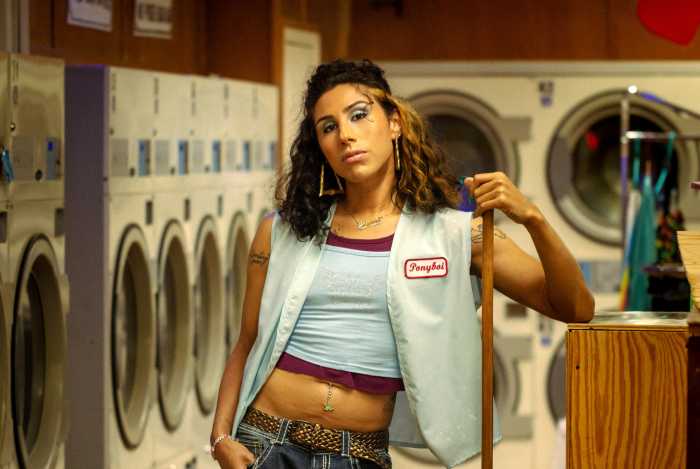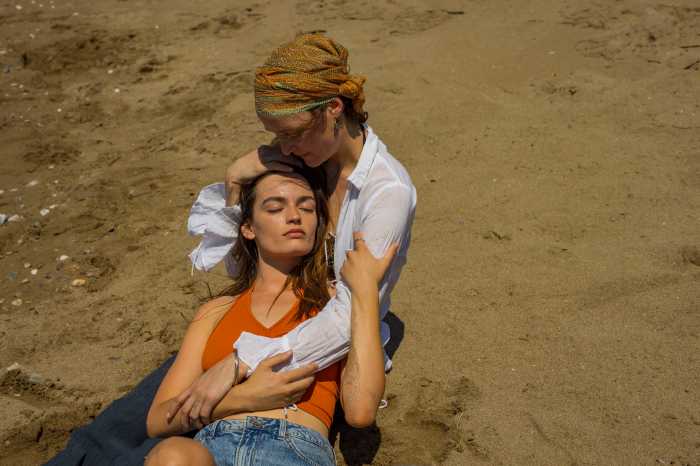“Spoonful of Sugar” is astonishingly cruel and misanthropic. None of its characters, not even a small boy, is a good person, but the most overtly eccentric comes closest. Yet its barbed view of middle-class life digs deeper than a brief look at the premise, in which Millicent (Morgan Saylor), a babysitter constantly tripping on LSD, takes a new job caring for Johnny (Danilo Grovetti), a boy with many health problems, might indicate. In fact, it reflects the outsider perspectives of director Mercedes Bryde Morgan, who’s both queer and Latinx, and writer Leah Saint Marie. “Spoonful of Sugar” shows how the nuclear family is built on a pile of bodies covered up by an assumption of wholesome togetherness.
Millicent puts a drop of LSD on her tongue before heading to a job interview with Rebecca (Kat Foster). Rebecca asks some strange, inappropriate questions, like “Do you have a boyfriend?” As her shirtless, handsome husband Jacob (Myko Olivier) works in the yard outside, the film’s style reflects Millicent’s desire, panning closer to him as the two women talk. Johnny, who likes to wear an astronaut costume, has yet to speak, although he often screams. Millicent’s drug use leads her to a strange fantasy life, yet her hallucinations refer to real triggers. She and Johnny prove to get along, yet their behavior together is unsettling. Millicent, who was raised by a creepy foster father (David Yow), claims to be 21, but she looks much younger. She comes to decide that LSD would be a good addition to Johnny’s daily medication.
“Spoonful of Sugar” does not take place in a world resembling the one we live in. The lighting and cinematography are autumnal. The locale is never stated, but it looks like suburban New England. Even the houses loom menacingly. They’re full of sharp, triangular angles, with windows that let in very little light. Morgan’s direction goes far beyond the very common use of dim cinematography in recent movies and TV. Many of the film’s scenes are readable only due to a glowing, misty shaft of light slicing through the frame. Its resemblance to a knife is no coincidence. Millicent’s use of LSD provides an excuse for certain stylistic touches. Occasionally, these get overblown, as in the scene where Millicent masturbates to a photo of Jacob and imagines him coming to life in her room to have sex with her while the image spins and glows with pink light.
A touch of queasy surrealism runs through the entirety of “Spoonful of Sugar.” As Millicent applies lipstick, she delivers a monologue to the camera, speaking directly to the audience. The lights change from brown to blue for no reason except her emotions (and the fact that she’s tripping.) The film puts Millicent’s experience in a mythological framework, including Christianity (with a nativity scene in the family’s backyard and characters constantly eating apples) and fairy tales. Most of all, “Alice in Wonderland” lies over it. It even plays a song by the ‘60s pop group the Berkley Kites named after Lewis Carroll’s book.
“Alice in Wonderland” has to come take on sinister connotations. Jefferson Airplane’s “White Rabbit” cemented it as a readymade allegory of psychedelic drug use. While Carroll’s attraction to the 11-year-old girl upon whom Alice was based has never been fully confirmed, it’s long been speculated that he was a pedophile. Both of these hang over “Spoonful of Sugar.” Johnny and Millicent follow the rabbit into some very grim places. He kills rabbits and buries them in the backyard. She demonstrates a gift for skinning their corpses, promising to make him a keychain from their paws. Later on, he hallucinates, seeing white rabbits flying through the air.
Especially with its allusions to pedophilia and relentless bleakness, some viewers are bound to write off “Spoonful of Sugar” as a piece of edgelord cinema. It arrives on Shudder at a time when the asexuality of current American cinema is a hotly debated topic on social media. While “Spoonful of Sugar” is full of sex, none is healthy. In fact, desire leads its characters towards dangerous behavior. (This is exemplified by a scene where Jacob almost gets into a car accident while Rebecca performs oral sex on him as he drives.) For sex-positivity to be more than a slogan, the film suggests that people like Millicent would need a space to explore their libidos without abuse or exploitation. She goes from the childlike look of her early scenes to revealing clothes, large amounts of makeup, and letting her hair down without ever shaking the perception that she’s catering to male images of girls and adult women. As bitter a pill as “Spoonful of Sugar” is, it conceals a hidden reservoir of empathy for outsiders, but has no illusions that their behavior will always be positive. It dives into moral grey areas with a gusto far out of fashion, steeped in a hothouse claustrophobia that feels real.
“Spoonful of Sugar” | Directed by Mercedes Bryan Morgan | Streams on Shudder starting March 3rd



































